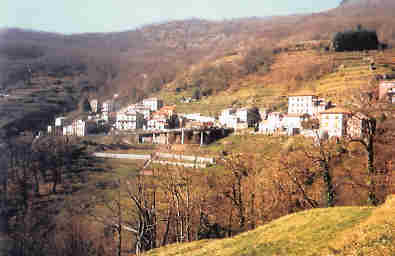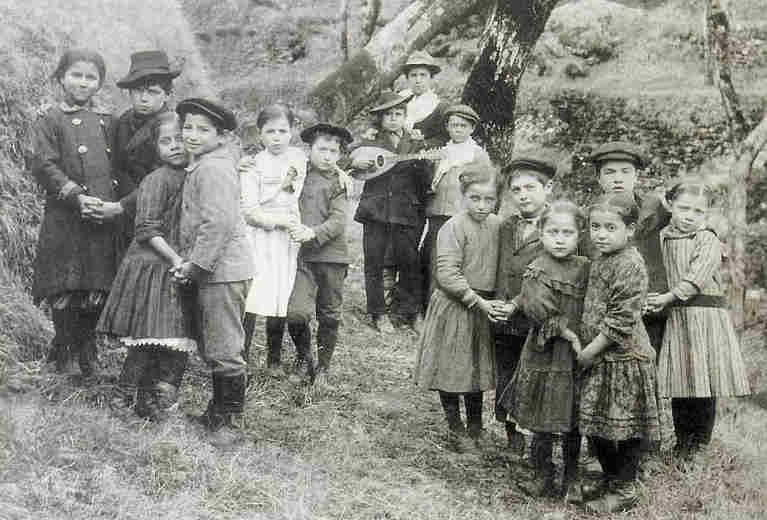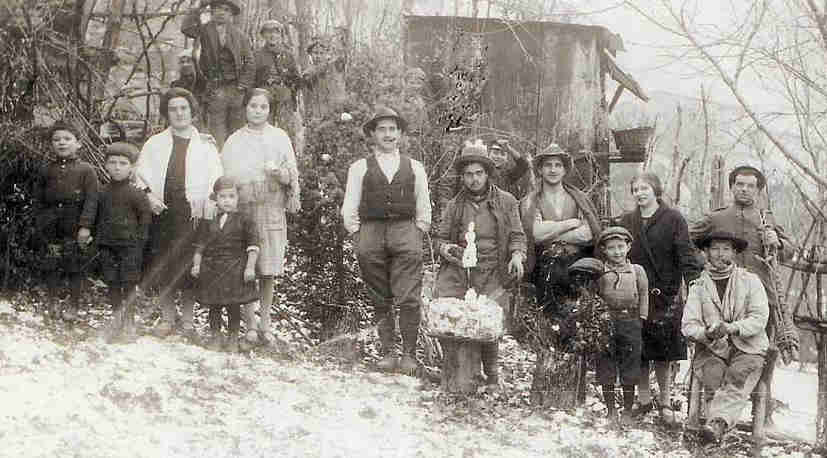| |
Castello (San Vincenzo)
“San Vincenzo (Castello) di Favale 1849 – In this hamlet of the commune of Favale, district of Cicagna, Province of Chiavari, in the Ligurian Apennines, at the summit of the valley called – because of the spring that spouts out of it – Fontanabuona, in 1849 began the religious history that we are about to evoke.”
To reach the resort it was necessary, and it still is, to travel on the road on the valley floor parallel to the Aurelia road going from Chiavari or from Rapallo or from Recco; once in Monleone it was necessary to go up along the valley, extensive and branched, of the Malvaro river that ends in Favale. This commune at the time had thirteen hamlets, San Vincenzo was the most populated one and, since it was the highest one, it was also called Castello di Favale (Castle of Favale).
The climate of the resort is healthy, but the work and production have always been insufficient for the life of the prolific population, thus the emigration has always been a predominant element.” (English translation from book “The Waldensian Evangelical Church of Favale 1849 - 1919 by: Paolo Sanfilippo - Genova 1971 - Federation of the Evangelical Churches in Liguria)
English translation of the book "Il mio Paese" by Padre Celso da Favale - pages 45-48
Castello is a name that comes from “castrum,” a Latin word that when translated in Italian means sacred place, for living and for work, sacred village protected and defended from eventual incursions. In fact in some houses of the village, as in others of the Fontanabuona, one can still notice narrow windows on the external part and more open on the inside, where the defense weapons were laid semi-hidden, and put into action in case of aggression.
 |
Castello - Fig 18 - Castello (422 meters). The sunny village – the most populated of the commune – rich of waters, woods and fields: protected by the surrounding mountains, presents a nice inhabited village that winds itself to make a frontier, and almost at the same level, the cry of an abandoned cemetery, the singing of a fountain defined “historical”. “It offers a picturesque painting that has for a frame the road of the three valleys. |
Castello, in the years before the emigration, had 34 “fires” (families) and about 300 inhabitants. Today it is still the most populous hamlet of the village. It’s sunny position favors agriculture at a family level.
For this reason terracing of the land is common with the construction of the so called cultivable ‘stripes’ or ‘plans’, united one to the other by walls (seggi) that can be walked on by the use of stairs made of stone. The houses, which are almost all laid out at the same level taking advantage of a less steep area, are made of local rocks and preserve the typical slate roof and the characteristic pergola in front of the entrance.
Two well-established family joineries honor the industriousness of the owners, Barbagelata Antonio and Cordano – Barbagelata Elio.
At the beginning of the hamlet there is a fountain out of which abundant water gushes every month of the year. Fine quality water, it is recommended not only for domestic use, but also for therapeutic uses. Numerous tourists always stop by the font.
| Castello - Figure 19 - Rural meeting of the “small ones,” united in a festivity of games; with limpid and watchful eyes they watch us, and dream. |
 |
The Favalesi, since the year of the reconstruction (1827) called it “Fontana da canà”. In the chapter “Le Fontane”, it is explained why this fountain was defined “historic”. In the proximity of the hamlet, an evangelic cemetery and former temple stand as signs of the presence of a Waldensian clan in the second half of the 1800s.
The hamlet, seen from above, offers a picturesque painting that has for a frame the road of the three valleys, that sees every day hundreds of cars passing by, going to Scoglina, Barbagelata and S. Stefano d’Aveto.
Feast of the snow in Castello
This peculiar picture, dated back to 1925, jealously preserved by mom Masilia Seglas, in which are depicted some of the inhabitants of Castello, is published with some nostalgia and regret of the good past times because it makes us live through the ancient savor of the real feast again, when few things were enough to have fun.
| Castello - Figure 21. - The feast of the snow. Picture taken in 1925. “The first snow was celebrated: for the children the joy of the games, for the adults the hope of a good crop.” |
 |
The fall of the first snow was in fact celebrated with lively human involvement and participation; for the children the joy of the games, for the adults the hope of a good crop.
The photographer Ada, called for the occasion, immortalized the scene and the smile of those people that knew how to joy.
PROJECT COORDINATOR FOR CASTELLO or SAN VINCENZO
Ginger Staral gstaral@comcast.net
If you have any information about Castello or ancestors from Castello, contact Ginger Staral
|

